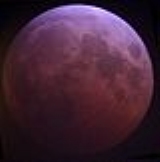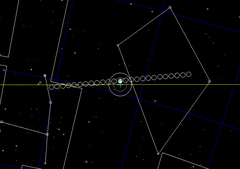
May 2003 lunar eclipse
Encyclopedia
| Total Lunar Eclipse May 15-16, 2003 |
|
|---|---|
 From Minneapolis, Minnesota Minneapolis, Minnesota Minneapolis , nicknamed "City of Lakes" and the "Mill City," is the county seat of Hennepin County, the largest city in the U.S. state of Minnesota, and the 48th largest in the United States... at 3:17 UT |
|
 The moon's path through the Earth's shadow. |
|
| Series (and member) Saros cycle The saros is a period of 223 synodic months , that can be used to predict eclipses of the Sun and Moon. One saros after an eclipse, the Sun, Earth, and Moon return to approximately the same relative geometry, and a nearly identical eclipse will occur, in what is referred to as an eclipse cycle... |
121 (55) |
| Duration (hr:mn:sc) | |
| Totality | 00:52:42 |
| Partial | 02:14:38 |
| Penumbral | 05:09:30 |
| Contacts | |
| P1 | 01:05:25 UTC |
| U1 | 02:02:51 UTC |
| U2 | 03:13:49 UTC |
| Greatest | 03:40:11 |
| U3 | 04:06:31 UTC |
| U4 | 05:17:29 UTC |
| P4 | 06:14:56 UTC |
 The moon's path across the Earth's shadow near its descending node in Libra Libra (constellation) Libra is a constellation of the zodiac. Its name is Latin for weighing scales, and its symbol is . It is fairly faint, with no first magnitude stars, and lies between Virgo to the west and Scorpius to the east.-Notable features:]... . |
|
A total lunar eclipse
Lunar eclipse
A lunar eclipse occurs when the Moon passes behind the Earth so that the Earth blocks the Sun's rays from striking the Moon. This can occur only when the Sun, Earth, and Moon are aligned exactly, or very closely so, with the Earth in the middle. Hence, a lunar eclipse can only occur the night of a...
took place on May 16, 2003, the first of two total lunar eclipses in 2003, the other being on November 9, 2003
November 2003 lunar eclipse
A total lunar eclipse took place on November 9, 2003, the second of two total lunar eclipses in 2003, the first being on May 16, 2003.-Photo gallery:-Lunar year series:It is the second of four lunar year cycles, repeating every 354 days....
.
Saros series
It is a member of Saros cycleSaros cycle
The saros is a period of 223 synodic months , that can be used to predict eclipses of the Sun and Moon. One saros after an eclipse, the Sun, Earth, and Moon return to approximately the same relative geometry, and a nearly identical eclipse will occur, in what is referred to as an eclipse cycle...
121.
Lunar year series
It is also the second of four lunar year cycles, repeating every 354 days.Metonic series
This eclipse is the second of four Metonic cycleMetonic cycle
In astronomy and calendar studies, the Metonic cycle or Enneadecaeteris is a period of very close to 19 years which is remarkable for being very nearly a common multiple of the solar year and the synodic month...
lunar eclipses on the same date, May 15-16, each separated by 19 years.
See also
- List of lunar eclipses and List of 21st century lunar eclipses
- November 2003 lunar eclipseNovember 2003 lunar eclipseA total lunar eclipse took place on November 9, 2003, the second of two total lunar eclipses in 2003, the first being on May 16, 2003.-Photo gallery:-Lunar year series:It is the second of four lunar year cycles, repeating every 354 days....
- October 2004 lunar eclipseOctober 2004 lunar eclipseA total lunar eclipse took place on October 28, 2004, the second of two total lunar eclipses in 2004, the first being on May 4, 2004.- Visibility :...
- May 2004 lunar eclipseMay 2004 lunar eclipseA total lunar eclipse took place on May 4, 2004, the first of two total lunar eclipses in 2004, the second being on October 28, 2004.- Visibility :...

